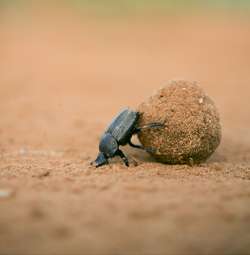(PhysOrg.com) -- The dung beetle dance, performed as the dung beetle moves away from the dung pile with his precious dung ball, is a mechanism to maintain the desired straight-line departure from the pile, according to a study published in today’s issue of the online journal PLoS ONE.
Upon locating a suitable dung pile, a ball-rolling dung beetle cuts off a piece of dung, shapes it into a ball and rolls it away to a distant location for burial and consumption. While rolling, the beetles move away from the dung pile in a straight line; a remarkable feat given that they do this facing backwards with their head pointing towards the ground. Rolling along a straight path is crucial for dung beetles because it guarantees that they will not return to the dung pile where they risk being attacked by other beetles who, rather than making their own ball, would prefer to capitalise on the work of others.
Moving along a straight line, either toward or away from a particular location, is important for survival in many different animals. The task of dung beetles is to move away from a specific location (the dung pile) in the most efficient way possible. Dung beetles move along a straight path using external visual cues like the sun, the moon or the pattern of polarised light that forms around them as a ‘compass’. Such a compass could be the Earth’s magnetic field, distant landmarks, the position of the sun or the moon or the polarisation pattern they generate in the sky.
Before rolling a new ball away from the dung pile, dung beetles perform a characteristic ‘‘dance’’, in which they climb on top of the ball and rotate about their vertical axis. This dance behaviour can also be observed during the beetles’ straight-line departure from the dung pile.
The study, led by Emily Baird of Lund University in Sweden, investigated the circumstances that cause the beetle to dance.
“The purpose of this dance, in which the beetle climbs to the top of the ball and rotates, was previously unknown,” says Prof. Marcus Byrne from the Wits School of Animal, Plant and Environmental Studies, a co-author of the paper. “We found that the dung beetles are most likely to perform the dance before moving away from the pile, upon encountering an obstacle, or if they have lost control of the ball. This suggests that the behaviour is crucial for keeping the ball moving in a straight line. Such direct, efficient navigation allows the beetle to quickly move away from the intense competition from other beetles at the dung pile.”
The authors explored the circumstances that elicit dance behaviour in the diurnal ball-rolling dung beetle, Scarabaeus (Kheper) nigroaeneus.
“Our results reveal that dances are elicited when the beetles lose control of their ball or lose contact with it altogether,” explains Byrne. “We also find that dances can be elicited by both active and passive deviations of course and by changes in visual cues alone. We thus conclude that the dung beetle dance is a visually mediated mechanism that facilitates straight-line orientation in ball-rolling dung beetles by allowing them to establish a roll bearing and return to this chosen bearing after experiencing a disturbance to the roll path.”
More information: Baird E, Byrne MJ, Smolka J, Warrant EJ, Dacke M (2012) The Dung Beetle Dance: An Orientation Behaviour? PLoS ONE 7(1): e30211. doi:10.1371/journal.pone.0030211 . Read the paper online here: www.plos.org/media/press/2012/pone-07-01-baird.pdf
Provided by University of the Witwatersrand























